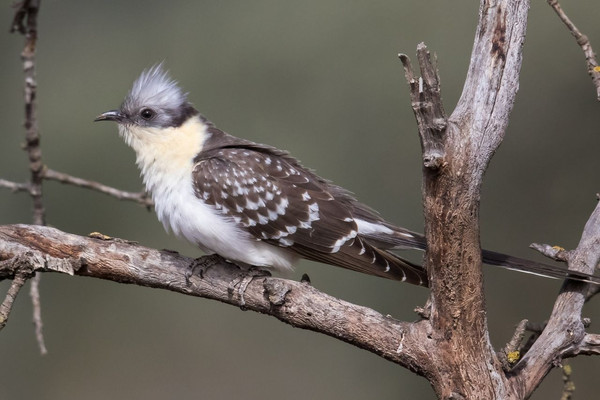Spain in Spring
 By Simon Woolley
By Simon WoolleyNaturetrek Tour Leader
15th September 2022
Every spring, Naturetrek offers up to 30 wildlife-watching trips to mainland Spain (plus more to the Balearic and Canary Islands offshore). In 2022, I was involved in leading four tours in the southern half of the country, bridging 400km north to south and all four months of the Spanish spring.
In February, Britain languishes in the tail end of winter, with the merest signs of spring beginning to announce themselves. In Extremadura, it is certainly still winter: great flocks of Lapwing and Golden Plover dominate the steppes, and myriad Meadow Pipits and White Wagtails throng the grasslands, along with wintering Hen Harriers, Merlins and other raptors. They winter alongside the resident ‘superstars’ of the Spanish steppe, which are easier to see while the grass is short and heat haze is minimal: Great and Little Bustards, Spanish Imperial Eagle, three species of vulture, Pin-tailed and Black-bellied Sandgrouse, Stone-curlew, Iberian Magpie and Iberian Grey Shrike. Common Cranes also winter in central Spain in large numbers, and are beginning to migrate by mid-February. They feed in Cork Oak groves and on abandoned rice fields, and can be seen heading north in flocks, sometimes of hundreds of birds.Yet spring is undeniably in the air: the White Storks have arrived and are displaying, Common Chiffchaffs are in every bush, the Barn Swallows are appearing, and Hoopoes and Great Spotted Cuckoos are among the early ‘exotic’ species just in. Bonus birds like Bluethroat and even a Red-billed Leiothrix made this a remarkable trip so early in the year.
In early March, I led a 2-centred tour, with the primary focus on finding the fabled Iberian Lynx. We had extended views of a female lynx close to her den in the hills of the Sierra Morena near Andújar, along with other mammals such as Mouflon and Iberian Ibex. The spring flowers were developing rapidly, with white and yellow brooms dominating, along with white and pink Cistuses and early bulbs. Insect-life was accelerating, with superb views of Swallowtail and Spanish Festoon butterflies, along with many others.

Great Spotted Cuckoo
Our second centre for this holiday was the fabled Coto Doñana, at the mouth of the Guadalquivir Delta near Seville. While we were unlucky with lynx at this site, we were immersed in a paradise of wetland birds, with flocks of Greater Flamingoes, Spoonbills, Glossy Ibises and many more. The waterbird specialities of southern Spain were seen too: Red-knobbed Coot, Marbled Duck, Ferruginous and White-headed Ducks. Migration was well under way now, with the arrival of numerous hirundines and some migrant passerines, and lots of passage waders such as Ruff, godwits, plovers and Black-winged Stilts. The spring flowers were in full bloom, and we enjoyed not only the wetlands of the Coto Doñana, but also the cool woodlands and the drier, sandy heaths and meadows, accompanied by numerous butterflies.
By the time of my next visit, in mid-April, spring was in its full glory, both in the Coto Doñana and in Extremadura. Almost all the breeding migrants had arrived and were singing/displaying/nesting, and all the winter visitors had now gone. We were treated to Bee-eaters, Golden Orioles, Rollers, Black Storks, an Eagle Owl, and other exotica, plus astounding views of all the star raptors, including low-altitude Bonelli’s Eagles right over our heads, and multiple Booted and Spanish Imperial Eagles. Lesser Kestrels were back in their breeding colonies, Whiskered Terns flew up and down outside our hotel, and we saw Western Subalpine and Orphean Warblers in full song. The grasslands and hills of Monfragüe National Park were in full bloom and alive with insects. Add in numerous Purple and Squacco Herons, Black-crowned Night-herons, point blank Little Owls and three displaying Red-necked Nightjars, and this was a tremendous trip. We even managed to see another Iberian Lynx, this one a male at extraordinarily close range!

Iberian Lynx
By early May, the warmth was building; central and southern Spain will be too hot for most by the end of the month. Doing the same itinerary as three weeks before was fascinating. I had the opportunity to follow individual birds and nests through the breeding cycle, seeing the stork and vulture chicks growing, and watching the progress of woodpecker and Bee-eater nests. Collared Pratincoles, Red-rumped Swallows and both Melodious and Western Olivaceous Warblers added to the fun, and we managed a few surprises, such as a migrant (Iberian) Pied Flycatcher and a roosting Scops Owl in an urban park!
Over the four trips, my personal tally for the Spanish spring was 233 species of birds, some 15 mammals, 30+ butterflies, a dozen dragonflies and innumerable beautiful plants and other insects.
So, when is the best time to visit Spain in spring? Simple answer: there is no perfect time! Every phase of the season has different things to offer, so you have the agony of choice. Certain species are available throughout (such as most of the raptors, many waterbirds, bustards and sandgrouse), but others (such as Cranes, Rollers and Lesser Kestrels) are only around early or late in the season. Early spring offers cooler temperatures and different flowers; by May, some of the plants are looking tired, but the insects are more numerous and all the migrant birds have arrived. Chances of Iberian Lynx are statistically better earlier in the year, but we saw one on a hot late April evening, so you never know!
Spain in spring is right on our doorstep, is among the very best destinations Naturetrek has to offer, and we have such a range of tours that there will be something for everybody. I haven’t even touched on the options of bears, wolves, wildcats, alpine flowers, dragonflies or reptiles on dedicated tours. With Naturetrek, you can even combine your wildlife-watching with wine sampling or improving your Spanish!




 Loading search...
Loading search...